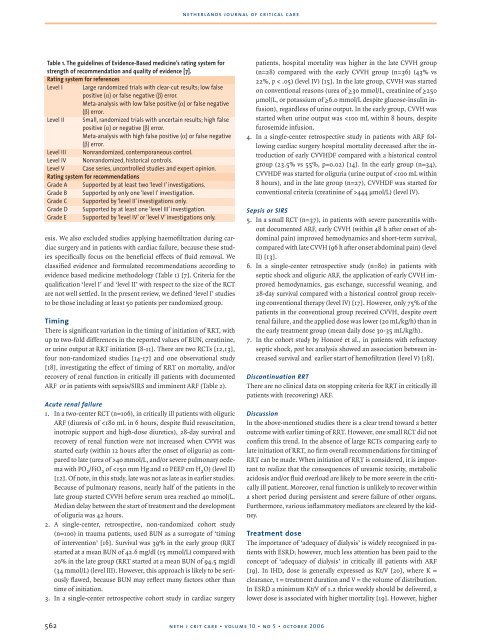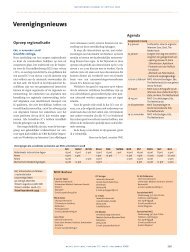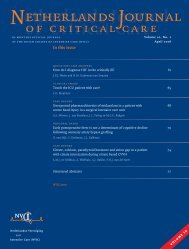Netherlands Journal
NJCC Volume 10, Oktober 2006
NJCC Volume 10, Oktober 2006
- No tags were found...
You also want an ePaper? Increase the reach of your titles
YUMPU automatically turns print PDFs into web optimized ePapers that Google loves.
netherlands journal of critical care<br />
Table 1. The guidelines of Evidence-Based medicine’s rating system for<br />
strength of recommendation and quality of evidence [7].<br />
Rating system for references<br />
Level I Large randomized trials with clear-cut results; low false<br />
positive (α) or false negative (β) error.<br />
Meta-analysis with low false positive (α) or false negative<br />
(β) error.<br />
Level II Small, randomized trials with uncertain results; high false<br />
positive (α) or negative (β) error.<br />
Meta-analysis with high false positive (α) or false negative<br />
(β) error.<br />
Level III Nonrandomized, contemporaneous control.<br />
Level IV Nonrandomized, historical controls.<br />
Level V Case series, uncontrolled studies and expert opinion.<br />
Rating system for recommendations<br />
Grade A Supported by at least two ‘level I’ investigations.<br />
Grade B Supported by only one ‘level I’ investigation.<br />
Grade C Supported by ‘level II’ investigations only.<br />
Grade D Supported by at least one ‘level III’ investigation.<br />
Grade E Supported by ‘level IV’ or ‘level V’ investigations only.<br />
esis. We also excluded studies applying haemofiltration during cardiac<br />
surgery and in patients with cardiac failure, because these studies<br />
specifically focus on the beneficial effects of fluid removal. We<br />
classified evidence and formulated recommendations according to<br />
evidence based medicine methodology (Table 1) [7]. Criteria for the<br />
qualification ‘level I’ and ‘level II’ with respect to the size of the RCT<br />
are not well settled. In the present review, we defined ‘level I’ studies<br />
to be those including at least 50 patients per randomized group.<br />
Timing<br />
There is significant variation in the timing of initiation of RRT, with<br />
up to two-fold differences in the reported values of BUN, creatinine,<br />
or urine output at RRT initiation [8-11]. There are two RCTs [12,13],<br />
four non-randomized studies [14-17] and one observational study<br />
[18], investigating the effect of timing of RRT on mortality, and/or<br />
recovery of renal function in critically ill patients with documented<br />
ARF or in patients with sepsis/SIRS and imminent ARF (Table 2).<br />
Acute renal failure<br />
1. In a two-center RCT (n=106), in critically ill patients with oliguric<br />
ARF (diuresis of 40 mmol/L, and/or severe pulmonary oedema<br />
with PO 2 /FiO 2 of







